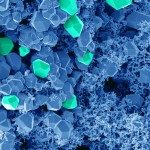About
Bacterial pathogens have evolved dedicated strategies to colonise organs, counter-attack and subvert host immune defence systems. Type IV secretion systems (T4SS) are molecular machineries produced by many bacterial pathogens, including Helicobacter pylori, Legionella pneumophila, Brucella suis, Bordetella pertusis or Bartonella henselae. T4SSs consist of around twelve proteins that form a molecular device that spans both bacterial membranes. It is prolonged in the external milieu by a pilus used to adhere to and/or to translocate effectors into host cells.
H. pylori is a Gram-negative bacterium that colonises the human stomach in half of the world population. It is estimated that 20% of individuals infected during their childhood will develop peptic ulcer disease, while gastric neoplasia will develop in 2-3% of infected individuals. For these reasons, H. pylori was defined as a group 1 carcinogen by World Health Organization (WHO). Strains associated with the most severe diseases contain the cytotoxin-associated gene cagA. CagA is a unique protein encoded by a gene located in the Cag pathogenicity island (CagPAI). This CagPAI encodes for 28 proteins that assemble a T4SS (cagT4SS) required to deliver CagA into the host cell. After translocation, CagA is tyrosine phosphorylated by host Src kinases and highjacks the signalling system of the cell. This leads to morphological changes in the cell, uncontrolled proliferation and provokes tumor apparition. CagA is therefore the major determinant of cancer development during H. pylori infection and is considered the paradigm of “bacterial carcinogenesis”. The mechanisms of injection of CagA by the cagT4SS are still poorly understood but it was found that the T4SS pilus proteins and CagA utilise a5ß1 integrin as a host cell receptor prior to substrate translocation. Interestingly, a5ß1 integrin, perhaps the most represented member of the integrin family, appears as a common receptor for numerous pathogens.
The objective of the proposed research program is to elucidate the structural and molecular basis of integrin a5ß1 utilisation by the H. pylori T4SS complex. Our research initiative builds upon recent exciting developments in our research groups and connects structural studies (X-ray crystallography, Small Angle X-ray Scattering (SAXS) and Electron Microscopy (EM)) with interaction studies and cellular assays. The proposal is based on the current collaborative work performed by three groups that has led to: 1) established protocols for purification of the proteins and interaction studies, 2) high resolution studies of CagA structure and identification of its a5ß1 integrin binding domain, 3) efficient in vivo assays to monitor the functional relevance of the interactions studied.
Our short-term goal is to decipher the molecular and structural details of (1) the interactions between pilus protein components (2) their interactions with the integrin a5ß1 receptor and (3) to determine the sequence of binding events/activation leading to CagA injection. The proposed program is timely given the recent maturation of the methods needed to tackle such complex research problems. Our groups have a history of successful collaboration and our expertise is genuinely complementary, hereby ensuring a more complete, integrated vision of the a5ß1 integrin exploitation by H. pylori. Although a5ß1 appears as a common receptor for many pathogens, no structural information is available concerning the details of these interactions. Because an increasing number of pathogens are identified to use integrins to mediate their infection, we believe that our program will impact the study of many infections. The long-term objectives are to better understand the molecular mechanisms of bacterial infection and to provide new therapeutic strategies, urgently needed to combat these infections.

